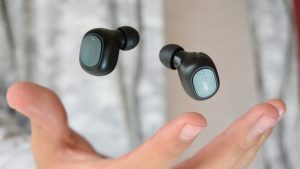Welcome to the ultimate guide on How to Choose Earbuds! With so many options available in the market, selecting the fitting earbuds can be overwhelming. Whether you are a music lover, a fitness enthusiast, or someone who simply wants to enjoy hands-free calling, this guide will help you make an informed decision. Let’s dive in!
Also, Read: Best Bluetooth Hearing Protection Earbuds: Reviews, Guide
Introduction
Earbuds have become an indispensable part of our daily lives. Whether commuting, exercising, or relaxing, having a good pair of earbuds can make all the difference. But with so many options on the market, choosing the right ones for your needs can be overwhelming. That’s why it’s essential to research and select earbuds that will provide the best listening experience for you.
I know how challenging it can be to navigate the sea of options. That’s why I’m here to help you make an informed decision without using technical jargon. There are a few key factors to consider regarding earbuds, such as sound quality, comfort, and durability. Considering these factors, you can find the perfect pair of earbuds that will meet your needs and exceed your expectations.
So, whether you’re an audiophile or just looking for a reliable pair of earbuds, choosing the right ones can make a difference. With my expertise and guidance, you’ll be well on your way to finding the perfect pair of earbuds for your unique needs and preferences. Let’s get started!
2. Determine Your Needs and Preferences
Understanding Earbud Types and Styles
Earbuds come in various shapes, sizes, and styles, each with unique features and benefits. One popular type is the in-ear earbud, which fits snugly inside the ear canal and provides excellent noise isolation. Another type is the over-ear earbud, which sits on the ear and is ideal for active use or sports activities. There are also wireless earbuds, which connect to your device via Bluetooth and are great for on-the-go use.
When it comes to style, you can choose between open or closed-back earbuds. Open-back earbuds allow for a better soundstage and a natural sound, while closed-back earbuds provide better noise isolation and bass response. Ultimately, the type and style of the earbud you choose will depend on your preferences and the activities you plan on using them for.
Identifying Your Needs and Preferences
Before choosing a pair of earbuds, you must identify your specific needs and preferences. Are you looking for earbuds for everyday use, or are you a severe audiophile looking for the highest quality sound? Do you plan on using your earbuds for commuting, working out, or both? Answering these questions will help you narrow your options and find a pair of earbuds that best suits your needs.
Setting Your Budget
Earbuds can vary in price from just a few dollars to hundreds, depending on their features and quality. Setting a budget for yourself before making a purchase is essential, as this will help you narrow down your options and avoid overspending. Remember that more expensive earbuds may offer better sound quality and additional features. However, there are also plenty of affordable options that provide excellent performance.
Considering Additional Features
In addition to sound quality and style, there are many additional features to consider when choosing a pair of earbuds. For example, some earbuds offer active noise canceling, blocking external noise for a more immersive listening experience. Others may have built-in microphones for taking phone calls or voice commands or come with a carrying case for easy storage and transport.
It’s essential to consider which features are most important to you and which you can do without. For example, if you use your earbuds primarily for listening to music, sound quality, and noise are.
3. Evaluating Sound Quality
Understanding Sound Quality
Sound quality is one of the most important factors to consider regarding earbuds. But what exactly is the sound quality? In simple terms, it refers to how clear and detailed the audio sounds and the balance between different frequencies such as bass, mids, and treble. Good earbuds should provide a well-rounded and enjoyable listening experience, whether listening to music, watching videos, or taking phone calls.
Factors that Affect Sound Quality
Several factors can affect the sound quality of your earbuds. One of the most important is the driver size, which is the component that converts electrical signals into sound waves. Generally, more significant drivers can produce more robust and detailed sound, but this also depends on the quality of the materials and engineering used.
Another factor is the frequency response range, which refers to the frequency range produced by earbuds. A wider frequency range generally means a more accurate and detailed sound. However, it’s important to note that most people can only hear frequencies up to 20kHz.
Factors that Affect Sound Quality
Other factors that can affect sound quality include the type of material used for the earbud housing, the cable or wireless connection quality, and the level of noise isolation or cancellation provided.
Testing Sound Quality
When evaluating the sound quality of earbuds, it’s essential to test them out in various situations and with different types of audio. For example, you might listen to various music genres to see how well the earbuds handle different instrumentation and vocals. You could also listen to podcasts or videos to see how well the earbuds reproduce speech and other types of audio.
It’s also important to consider the environment in which you’ll use the earbuds. Testing them in a quiet room may not accurately reflect their performance in a noisy subway or crowded coffee shop.
Ultimately, the best way to evaluate the sound quality of earbuds is to trust your ears and preferences. Everyone’s ears and preferences are different, so what sounds significant to one person may not sound as good to another. By considering the factors that affect sound quality and testing out different earbuds for yourself, you can find a pair that perfectly balances sound and comfort for your needs.
4. Assessing Comfort and Fit
Understanding Earbud Fit
The fit of an earbud refers to how well it sits in your ear. A good fit should feel snug but not too tight. It should also create a seal between the earbud and your ear canal, essential for producing high-quality sound. Choosing the suitable size earbuds for your ear to achieve the perfect fit would be best.
Choosing the Right Earbud Size
Earbuds typically come with different sizes of ear tips, ranging from small to large. To find the right size for your ear, you’ll need to experiment with different sizes until you find the one that fits snugly but comfortably. Remember that the size of your ear canal can vary between your left and right ears so you may need different sizes for each ear.
Assessing Earbud Comfort
Comfort is another essential factor to consider when choosing earbuds. Suppose you’re planning on using your earbuds for an extended period. In that case, you’ll want to ensure they feel comfortable in your ears. Look for earbuds with soft, flexible materials that won’t irritate your skin or cause discomfort. It would be best if you also considered the shape of the earbud and how it sits in your ear. Some earbuds are designed to sit snugly in your ear, while others may hang down or wrap around the back of your neck.
By understanding earbud fit and comfort, you can choose a pair that will provide a comfortable listening experience while delivering high-quality sound. Keep these factors in mind when shopping for your next pair of earbuds.

5. Evaluating Durability and Build Quality
Understanding Durability and Build Quality
To understand the durability and build quality, it’s essential to consider how the earbuds are made. Earbuds made with high-quality materials and a solid design are generally more durable than those made with lower-quality materials. Additionally, earbuds built with care and precision are typically more reliable than those hastily put together.
Materials and Design
Materials and design are two essential factors contributing to earbuds’ durability and build quality. For example, earbuds made with durable materials such as metal or high-quality plastics are generally more durable than those made with cheaper materials. Additionally, earbuds designed with features like reinforced cables or water-resistant coatings are often more durable than those without these features.
Reading Reviews and Product Specifications
One way to assess earbuds’ durability and build quality is to read reviews from other users. Reviews can provide valuable insights into the experiences of other users, including how durable the earbuds are and how well they are constructed. Additionally, reading the product specifications can provide information on the materials and design of the earbuds, as well as any features that contribute to their durability and build quality.
As an expert in earbuds, it’s essential to understand the factors contributing to their durability and build quality. By considering materials, design, reviews, and product specifications, you can make an informed decision when choosing a pair of earbuds that will last you for years.
6. Considering Other Factors
Compatibility with Your Device
It’s vital to ensure that the earbuds you choose are compatible with the device you plan to use them with. Some earbuds are explicitly designed for specific devices. In contrast, others are more versatile and can be used with various devices. Be sure to check the product specifications to ensure compatibility with your device before making a purchase.
Noise Cancellation and Ambient Sound
If you plan to use your earbuds in noisy environments, noise cancellation can be an essential feature to look for. This feature can block out external sounds, allowing you to focus better on your music or other audio. On the other hand, some people prefer to hear their surroundings while using earbuds, in which case ambient sound features can be helpful too.
Battery Life and Charging
Regarding earbuds, battery life is an essential factor to consider. Most earbuds have a battery life of around 4-6 hours, but some models can last up to 10 hours or more on a single charge. However, remember that the battery life can vary depending on how frequently you use them and what features you have turned on. The last thing you want is to have your earbuds die in the middle of your favorite song.
In addition to battery life, consider the charging time and options. Some earbuds require a wired connection, while others come with a wireless charging case. Wireless charging is becoming increasingly popular and convenient, as you can place your earbuds in their case to charge without any cords.
Noise Cancellation and Ambient Sound
Suppose you plan on using your earbuds in noisy environments or during workouts. In that case, noise cancellation and ambient sound features are worth considering. Noise cancellation technology uses microphones to block out external noise, allowing you to focus on your music or calls without distraction. Some earbuds also offer ambient sound features, which allow you to hear the outside world while still listening to your music.
However, remember that noise cancellation and ambient sound features can impact the battery life of your earbuds. It’s also important to note that noise cancellation may only partially block out all external noise, especially in loud environments.
Brand Reputation and Warranty
Finally, it would be best to consider the brand reputation and warranty when choosing earbuds. A well-known and reputable brand is more likely to produce high-quality, reliable earbuds. It’s also important to check the warranty information, as some brands offer more extended warranties than others.
In addition to the warranty, you should also consider the customer service and support provided by the brand. Do they have a helpful and responsive customer service team? Do they offer support for any issues or questions you may have?
Considering all these factors, you can find the perfect pair of earbuds that meet your needs and preferences. Remember to take your time and research to ensure you make an informed decision.
Conclusion
In conclusion, selecting fitting earbuds is essential for an enjoyable listening experience. Considering factors such as sound quality, comfort, durability, compatibility, battery life, and noise cancellation is crucial. Pay attention to frequency response, drivers, and codec support to evaluate sound quality.
Choosing the right earbud size and assessing comfort is critical to avoid discomfort during extended use. Regarding durability and build quality, look at materials, and design, and review product specifications.
Additionally, consider factors such as compatibility with your device, battery life and charging, noise cancellation, and ambient sound. Lastly, brand reputation and warranty can help you make an informed decision. Considering these factors, you can find the perfect earbuds to suit your needs and preferences.






